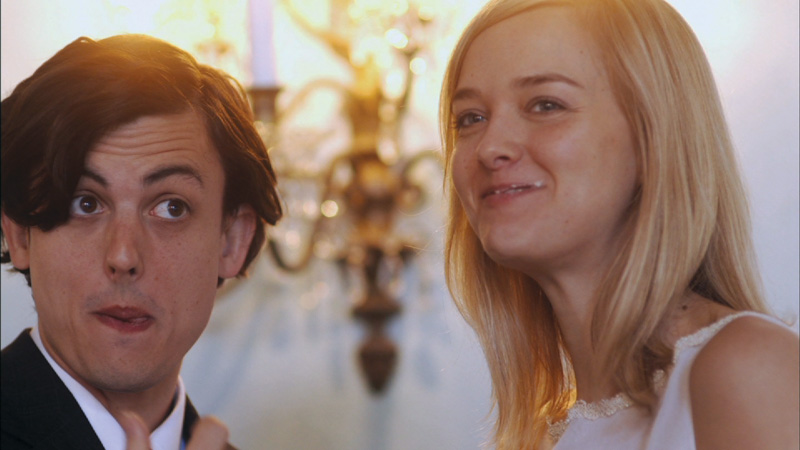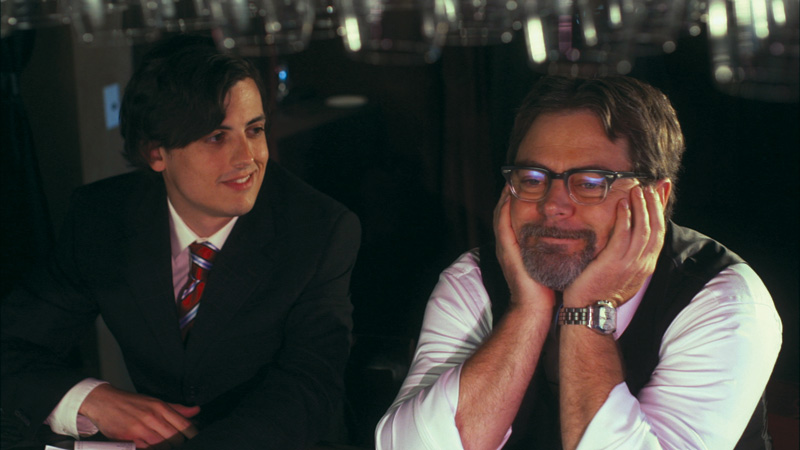
Life Or Nothing Like It
A version of this story ran in the May 2013 issue.
Above: Keith Poulson and Jess Weixler in Somebody Up There Likes Me.
Call it the 21st-century cinema temptation: a talented young director, overflowing with ideas and blessed with an idiosyncratic eye, decides to leave behind the complications of actual life and settle instead for the less satisfying but more easily accessible rewards of quirkiness. Out go the in-depth observations about the human condition and the scenes of emotional resonance, in come the bizarre costumes, self-conscious camera movements, clever intertitles, adorable soundtracks, and set-design trinketry.
The phenomenon started with Wes Anderson’s third film, The Royal Tenenbaums. Anderson, an admitted and obvious lover of the French New Wave, doesn’t just buy into that school’s auteur theory as the governing principle of filmmaking; he views the creation of a wholly fabricated world as the fundamental role of filmmaking. According to Anderson, and others like him, movies shouldn’t hold a mirror to nature; movies should hold a mirror to movies—in particular, to the director’s other movies.
Quentin Tarantino—with Anderson, one of the most influential directors of his generation—has taken all kinds of heat over the years for making movies that employ other movies as the blueprint for their realities and, as a result, fail to connect with those of us who live our lives predominantly outside of movie theaters. But Anderson has taken that approach one step further, fabricating realities in which there is no meaning beyond the frame of an individually perfect shot, because the director’s vision allows for no reference to any world outside of the camera.
Five years ago, Austin writer/director Bob Byington released Harmony and Me, a deadpan black comedy about a disenchanted hipster who has little to do with his time but talk to other people about the fact that his girlfriend just broke up with him. Though indebted in some ways to Anderson, Harmony and Me transcended its aesthetic influences by showing that beneath all the layers of irony, its characters were actually filled with honest emotions—disappointment, anger and petulance, yes, but emotions nonetheless. The movie’s centerpiece is a scene in which Austin musician Bob Schneider, playing a libidinous wedding singer, alternates between teaching the heartbroken Harmony one of his own heaviest heartbreak songs and trying to seduce the bride with that same song. The scene contains a whole world of contradictory emotions. It’s funny and defiant and pained and resigned all at the same time.
Byington’s latest, Somebody Up There Likes Me, contains no moments that even try to compare with that sequence’s emotional complexity, or emotional simplicity. Instead it employs a rigid devotion to deadpan, keeping the story’s humanity at a safe and manageable distance, locked behind walls of dispassion.

Offerman in Somebody Up There Likes Me. Photos courtesy of Tribeca Film
The movie’s protagonist, a young man with a magical briefcase that keeps him young (but not happy) as he works his way through two marriages, an affair, and a lifelong friendship with a loudmouth coworker, is defined more by turns of phrase than by humanity. Like post-Tenenbaums Anderson, Byington has decided to move his considerable talents away from understanding people and toward sustaining tone.
Where Harmony took his unfortunate fate on the chin, Somebody’s Max may as well be an observer of his own life. When we first meet him, Max is reacting to finding his wife in bed with another man as if he had just walked in on her watching a television show he doesn’t care for. Later, he absorbs the infidelities of his second wife, and the indifference of his mistress, with the same sense of cosmic resignation. Byington treats his hero’s eventual death with all the gravitas of a slip on a banana peel. Max’s demise carries no import because Byington has already long established that Somebody Up There Likes Me isn’t about people and their experiences; it’s about the animated intertitles explaining how many years have passed between scenes; it’s about the female lead’s adorable addiction to breadsticks; it’s about awkward wedding speeches, characters who wear baseball caps from age 5 into their 30s; and it’s about the perfect squeak a stuffed animal makes when it’s stabbed with a bouquet of flowers. It’s about quirkiness and the empty, temporary satisfactions that quirk provides.
What Byington is doing, like Anderson before him, is backing away from the perils of making movies that say something about who we are, and settling instead for making movies that amount to wish-fulfillment fantasies for the too-clever tinkerers who conceived them. The first route leads to art, the second to dollhouses.


